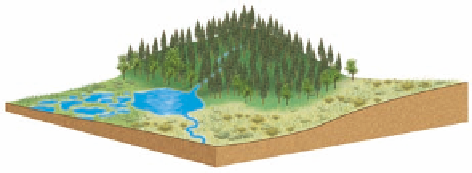Environmental Engineering Reference
In-Depth Information
Since the late 1960s, ecologists have explored the
use of
systems analysis
to develop mathematical and
other models that simulate ecosystems. Computer
simulations can help us understand large and very
complex systems (such as rivers, oceans, forests,
grasslands, cities, and climate) that cannot be ade-
quately studied and modeled in field and laboratory
research. Figure 3-32 outlines the major stages of sys-
tems analysis.
Researchers can change values of the variables in
their computer models to project possible changes in
environmental conditions, anticipate environmental
surprises, and analyze the effectiveness of various al-
ternative solutions to environmental problems.
Of course, the simulations and projections made
using ecosystem models are no better than the data
and assumptions used to develop the models. Clearly,
careful field and laboratory ecological research must
be used to provide the baseline data and determine the
causal relationships between key variables needed to
develop and test ecosystem models.
Critical nesting site
locations
USDA Forest Service
USDA
Forest Service
Private
owner 1
Private owner 2
Topography
Habitat type
Forest
Wetland
Lake
Grassland
Real world
Define objectives
Identify and inventory variables
Obtain baseline data on variables
Systems
Measurement
Figure 3-31
Geographic information systems
provide the com-
puter technology for organizing, storing, and analyzing complex
data collected over broad geographic areas. They enable sci-
entists to overlay many layers of data (such as soils, topogra-
phy, distribution of endangered populations, and land protec-
tion status).
Make statistical analysis of
relationships among variables
Determine significant interactions
Data
Analysis
model ecosystems and populations under laboratory
conditions. Such simplified systems have been created
in containers such as culture tubes, bottles, aquarium
tanks, and greenhouses and in indoor and outdoor
chambers where temperature, light, CO
2
, humidity,
and other variables can be controlled carefully.
Such systems make it easier for scientists to carry
out controlled experiments. In addition, the laboratory
experiments often are quicker and cheaper than simi-
lar experiments in the field.
But there is a catch. We must consider whether
what scientists observe and measure in a simplified,
controlled system under laboratory conditions takes
place in the same way in the more complex and dy-
namic conditions found in nature. Thus the results of
laboratory research must be coupled with and sup-
ported by field research.
Construct mathematical model
describing interactions among
variables
System
Modeling
Run the model on a computer,
with values entered for different
variables
System
Simulation
Evaluate best ways to achieve
objectives
System
Optimization
Systems Analysis
Ecologists develop mathematical and other models to
simulate the behavior of ecosystems.
Figure 3-32
Major stages of systems analysis. (Modified data
from Charles Southwick)







































